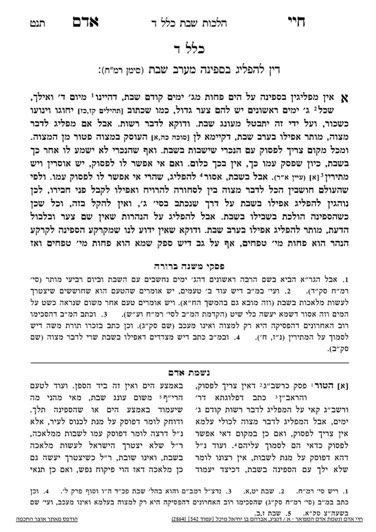We are continuing in siman 1. We will not learn this part of the siman inside, but will touch on the points introduced by the Chayei Adam and clarify them. The main idea behind learning this Klal is that some of the ideas introduced have relevance beyond the Klal itself, so we will go through them. Of course, these ideas are also relevant in literal application, even if less common.
The Chayei Adam touches on the issue of techum. To understand the issue, we need to introduce five points.
- There is a concept of techum, a limited area within which a person must stay on Shabbos. There is an opinion that techum is deoraysa, based on the pasuk of al yetzei ish mimekomo bayom hashevi’i.
- There are two shiurim given in regards to techum. The first is 2000 amos, equal to one mil, beyond the inhabited area of the city in which one lives. Throughout the inhabited area itself, there is no limit imposed. Once the city limits have been reached, and the area is no longer inhabited, a person cannot walk more than 2000 amos beyond the city. We will translate 2000 amos into a contemporary equivalency in a different shiur. This shiur is derabannon.
- Another shiur given is three parsa, or twelve mil. This translates into 24,000 amos, which is 12 times the previous shiur. It is a machlokes whether this shiur is assur deoraysa. Many poskim pasken that this shiur is deoraysa.
- Even according to those who hold that the shiur of 12 mil is deoraysa, it only applies when traveling on land. When one is traveling on rivers or seas, there is no techum on the Torah level.
- One scenario is if a person walks on a thin ridge, where the top of the wall is less than 4 tefachim wide but taller than 10 tefachim tall.
- Another example, brought by Rashi, is using the sheim Hashem to fly.
- A third possibility given is travel by boat. Assuming that we measure the height from the riverbed, a boat which is more than 10 tefachim above the riverbed would fall into this question.
- There are shiurim for techum. The smaller one, of 2000 amos beyond the city, is derabanan. The larger one, of 12 parsa, is a assumed to be deoraysa.
- The concept of techum does not apply to a river mideoraysa.



